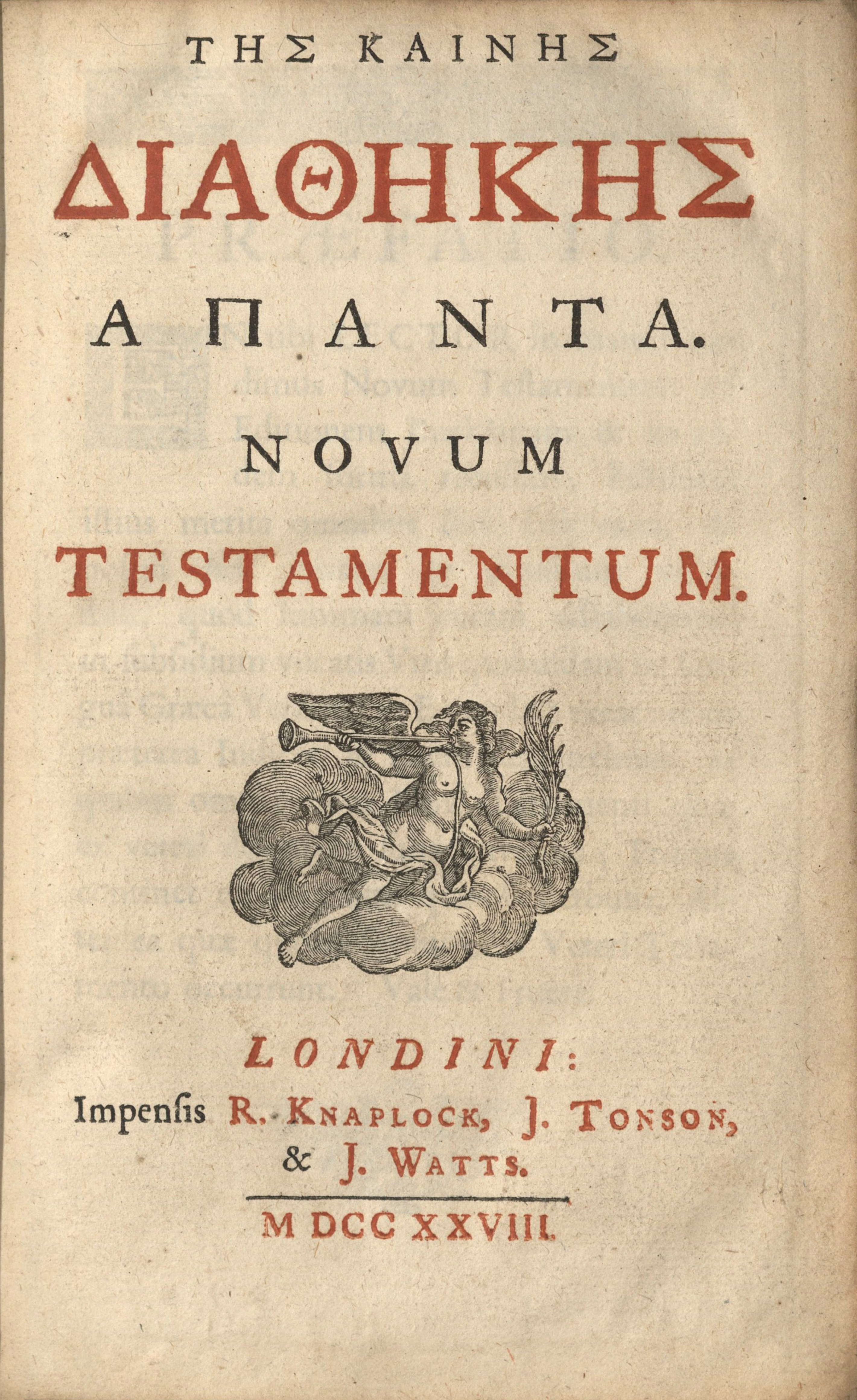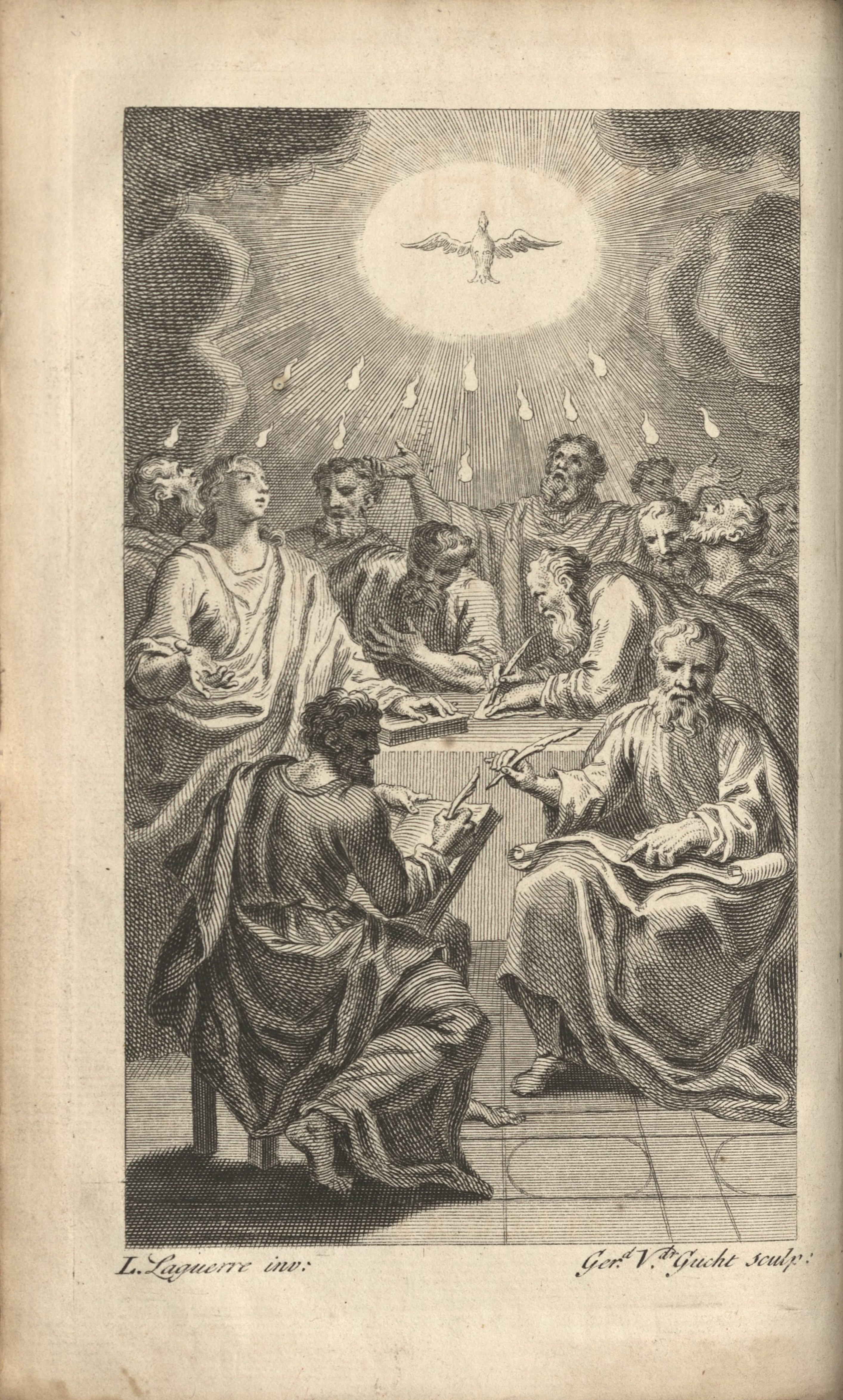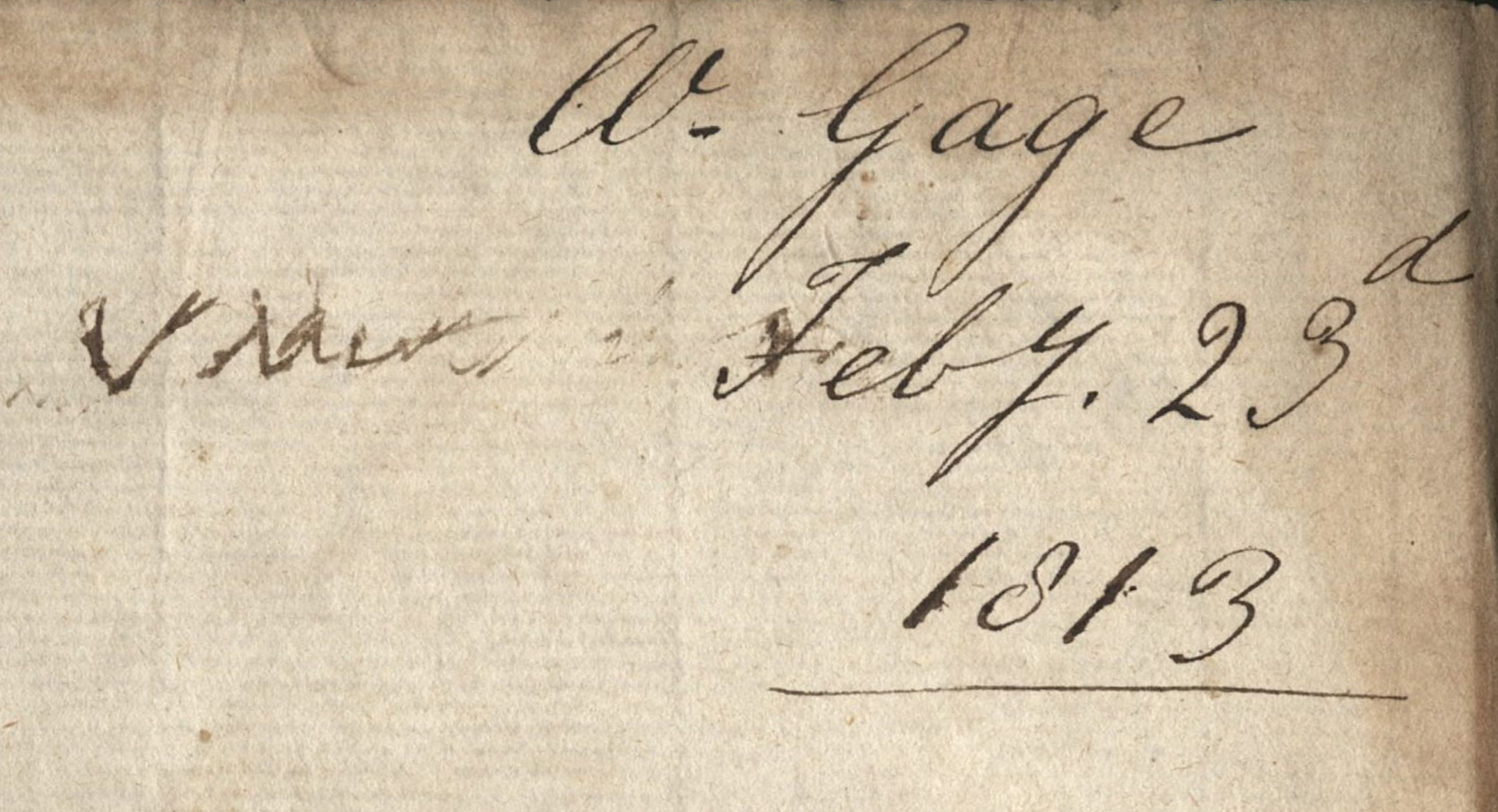Difference between revisions of "Kaines Diathekes Apanta"
m |
(Rewrite of blurb) |
||
| Line 15: | Line 15: | ||
|shelf=B-1 | |shelf=B-1 | ||
}}[[File:NovumTestamentum1728 Frontispiece.jpg|left|thumb|250px|<center>Frontispiece.</center>]] | }}[[File:NovumTestamentum1728 Frontispiece.jpg|left|thumb|250px|<center>Frontispiece.</center>]] | ||
| − | The second part of the Christian biblical canon, the | + | The second part of the Christian biblical canon, the [[wikipedia: New Testament| New Testament]] consists of several texts originally written in [[wikipedia: Koine Greek| Koine Greek]]. Historians do not know when the first compilation of the New Testament occurred, nor do they know who compiled it.<ref>Bruce M. Metzger "History of Editing the Greek New Testament," ''Proceedings of the American Philosophical Society'' 131, no. 2 (1987): 148.</ref> The [[wikipedia:Complutensian_Polyglot_Bible|Complutensian Polyglot Bible]] edited by [[wikipedia:Francisco_Jiménez_de_Cisneros|Cardinal Francisco Jiménez de Cisneros]] (1436-1517) included the first printed Greek New Testament (1514) but the 1516 edition by [[wikipedia:Erasmus|Desiderius Erasmus]] preceded the delayed publication of the Polyglot Bible by four years.<ref>Ibid, 70.</ref><ref>D. Parker, "[https://www.oxfordreference.com/view/10.1093/acref/9780198601180.001.0001/acref-9780198601180-chapter-6 The New Testament]," in ''The Oxford Illustrated History of the Bible'', accessed March 31, 2023.</ref> Unfortunately, Erasmus used a limited number of relatively recent, incomplete Greek texts and translated back from the Latin [[wikipedia:Vulgate|Vulgate]] when lacking the material he needed. The result has been dubbed "the most inaccurate book ever printed."<ref>Parker, "The New Testament."</ref> It influenced all subsequent versions of the New Testament printed until the nineteenth century.<ref>Charles B. Puskas and C. Michael Robbins, ''An Introduction to the New Testament'' (Cambridge: The Lutterworth Press, 2011): 70.</ref> |
| + | |||
| + | ''Tes Kaines Diathekes Apanta'', printed in London in 1728, follows in the line of Greek New Testaments derived from the editions of Erasmus and specifically falls in the family of "Editiones Stehano-Elzvirianae." So dubbed by Eduard Reuss in his 1872 book ''Bibliotheca Novi Testamenti Graeci'', these editions emanate from a combination of New Testaments produced by [[wikipedia:Robert_Estienne|Robert Estienne]] (Stephanus) in the early sixteenth century and those published by Dutch printers [[wikipedia:House_of_Elzevir|Bonaventure and Abraham Elzevir]] in the early seventeenth century.<ref>Metzger, "History of Editing the Greek New Testament."</ref> The 1728 London edition more specifically relied upon the "editionem Buckianam," a 1624 Greek New Testament published by University of Cambridge printer, Thomas Buck.<ref>Eduard Reuss, ''Bibliotheca Novi Testamenti Graeci'' (Brunswick: Apud C. A. Sshwetschke et Filium, 1872): 138, 140.</ref> | ||
==Evidence for Inclusion in Wythe's Library== | ==Evidence for Inclusion in Wythe's Library== | ||
Revision as of 15:49, 31 March 2023
| Novum Testamentum | |
|
Title page from Novum Testamentum, George Wythe Collection, Wolf Law Library, College of William & Mary. | |
| Published | Londini: Impensis R. Knaplock, J. Tonson, & J. Watts |
| Date | 1728 |
| Edition | ad Editionem Buckianam |
| Language | Greek |
| Pages | [4], 624 p., [1] leaf of plates |
| Desc. | Octavo (20 cm.) |
| Location | Shelf B-1 |
The second part of the Christian biblical canon, the New Testament consists of several texts originally written in Koine Greek. Historians do not know when the first compilation of the New Testament occurred, nor do they know who compiled it.[1] The Complutensian Polyglot Bible edited by Cardinal Francisco Jiménez de Cisneros (1436-1517) included the first printed Greek New Testament (1514) but the 1516 edition by Desiderius Erasmus preceded the delayed publication of the Polyglot Bible by four years.[2][3] Unfortunately, Erasmus used a limited number of relatively recent, incomplete Greek texts and translated back from the Latin Vulgate when lacking the material he needed. The result has been dubbed "the most inaccurate book ever printed."[4] It influenced all subsequent versions of the New Testament printed until the nineteenth century.[5]
Tes Kaines Diathekes Apanta, printed in London in 1728, follows in the line of Greek New Testaments derived from the editions of Erasmus and specifically falls in the family of "Editiones Stehano-Elzvirianae." So dubbed by Eduard Reuss in his 1872 book Bibliotheca Novi Testamenti Graeci, these editions emanate from a combination of New Testaments produced by Robert Estienne (Stephanus) in the early sixteenth century and those published by Dutch printers Bonaventure and Abraham Elzevir in the early seventeenth century.[6] The 1728 London edition more specifically relied upon the "editionem Buckianam," a 1624 Greek New Testament published by University of Cambridge printer, Thomas Buck.[7]
Evidence for Inclusion in Wythe's Library
There is no doubt that Wythe owned this title—a copy of the 1728 edition of "Novum testamentum. Gr. 8vo. Lond." at the Library of Congress includes George Wythe's bookplate. Thomas Jefferson also listed "Novum Testamentum" in his inventory of Wythe's Library, noting that he kept the volume himself. He later sold it to the Library of Congress in 1815.[8] Unsurprisingly, both George Wythe's Library[9] on LibraryThing and the Brown Bibliography[10] list the 1728 edition. Based on the copy at the Library of Congress, the Wolf Law Library purchased the same edition of Kaines Diathekes Apanta.
Description of the Wolf Law Library's copy
Bound in contemporary leather. Double gilt rules line edges of boards and frame five bands on spine. Inscription of former owner , "W. Gage, Feby. 23rd, 1813" on front free endpaper.
Images of the library's copy of this book are available on Flickr. View the record for this book in William & Mary's online catalog.
See also
- The Holy Bible, Containing the Old and New Testaments
- Jefferson Inventory
- Hē Kainē Diathēkē. Novum Testamentum
- Tēs Kainēs Diathēkēs Hapanta = Novum Testamentum
- Hē Palaia Diatheke Kata tous Hebdomenkonta = Vetus Testamentum Græcum
- Psaltērion Psalterium
- Wythe's Library
References
- ↑ Bruce M. Metzger "History of Editing the Greek New Testament," Proceedings of the American Philosophical Society 131, no. 2 (1987): 148.
- ↑ Ibid, 70.
- ↑ D. Parker, "The New Testament," in The Oxford Illustrated History of the Bible, accessed March 31, 2023.
- ↑ Parker, "The New Testament."
- ↑ Charles B. Puskas and C. Michael Robbins, An Introduction to the New Testament (Cambridge: The Lutterworth Press, 2011): 70.
- ↑ Metzger, "History of Editing the Greek New Testament."
- ↑ Eduard Reuss, Bibliotheca Novi Testamenti Graeci (Brunswick: Apud C. A. Sshwetschke et Filium, 1872): 138, 140.
- ↑ E. Millicent Sowerby, Catalogue of the Library of Thomas Jefferson, (Washington, D.C.: The Library of Congress, 1952-1959), 2:99 [no.1479].
- ↑ LibraryThing, s.v. "Member: George Wythe," accessed on November 19, 2013.
- ↑ Bennie Brown, "The Library of George Wythe of Williamsburg and Richmond," (unpublished manuscript, May, 2012) Microsoft Word file. Earlier edition available at: https://digitalarchive.wm.edu/handle/10288/13433.


